一、游标
使用游标,我们可以对具体操作数据,比如查询的结果,对行,列数据进行更加细致的处理。以及对其他DML
操作进行判断等操作;类似一个数据集合。
1、语法
declare cursor 游标名称 is 查询的sql;示例:
declare cursor cu_book is select bookname,price from t_book;注意:游标默认是关闭的。
2、打开右边
open 游标名;示例:
open cu_book;3、关闭游标
close 游标名;示例:
close cu_book;4、游标循环
fetch 游标名 into 临时值1,临时值2...;循环将游标中的字段保存到临时值中。
5、判断游标是否还有记录
游标名%found二、示例
set serverout on;
--定义游标哦
declare cursor cu_book is select bookname,price from t_book;
b_name varchar(20);
b_price number;
begin
open cu_book; --打开游标
fetch cu_book into b_name,b_price; --循环游标取值
while cu_book%found loop --如果游标里面还有值就循环处理其它逻辑
dbms_output.put_line('书名:' || b_name || '价格' || b_price);
fetch cu_book into b_name,b_price;
end loop;
close cu_book;
end;输出结果:
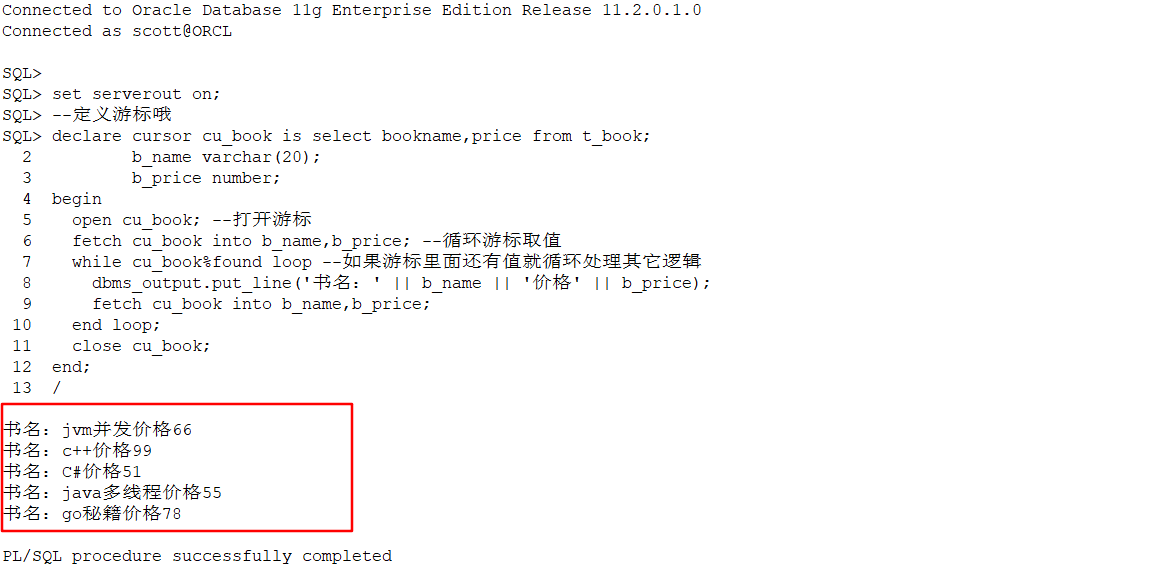
三、注意事项
1、定义的游标默认是关闭的。
2、while条件注意跳出。
3、注意关闭游标。
4、loop要有对应的end loop
四、显示游标
1、显示游标
上面定义的临时变量的类型必须和游标里面查询表的字段类型一样,如果表的字段类型改了,定义的临时变量就会报错,类型不一样。
因此就出现了显示游标。
定义:
临时变量名 表明.字段名%type;上面一中示例改进成显示游标:
set serverout on;
--定义游标哦
declare cursor cu_book is select bookname,price from t_book;
b_name t_book.bookname%type;
b_price t_book.price%type;
begin
open cu_book; --打开游标
fetch cu_book into b_name,b_price; --循环游标取值
while cu_book%found loop --如果游标里面还有值就循环处理其它逻辑
dbms_output.put_line('书名:' || b_name || '价格' || b_price);
fetch cu_book into b_name,b_price;
end loop;
close cu_book;
end;输出结果:
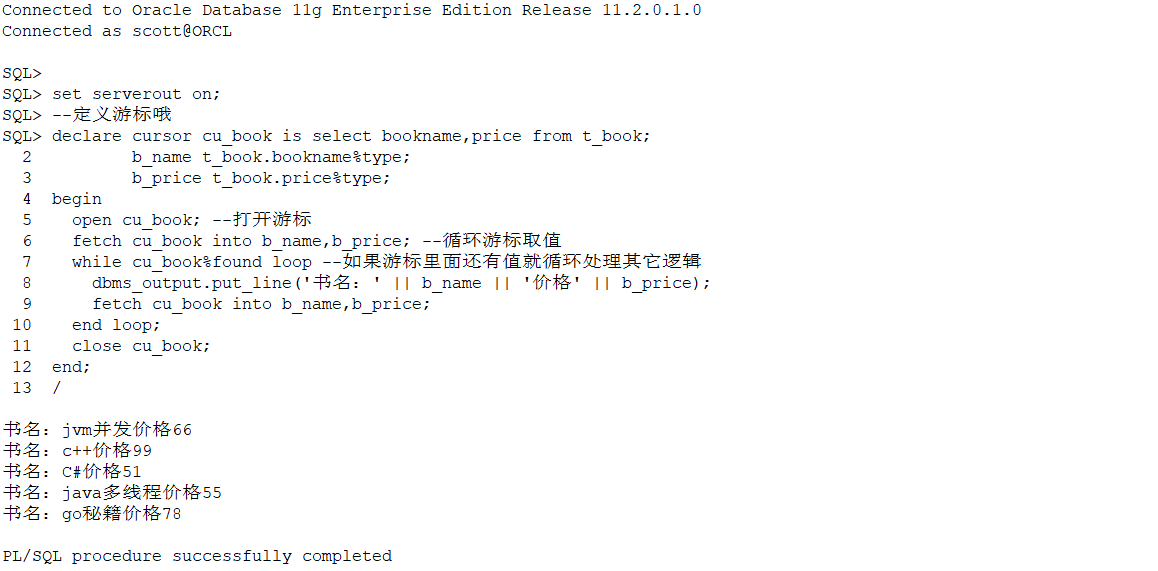
2、字段类型
表示表中字段数据类型。
%type3、行类型
表示表中一行数据类型。
%rowtype示例:
set serverout on;
--定义游标哦
declare cursor cu_book is select * from t_book;
book t_book%rowtype; -- 行类型
begin
open cu_book; --打开游标
fetch cu_book into book; --循环游标取值
while cu_book%found loop --如果游标里面还有值就循环处理其它逻辑
dbms_output.put_line('书名:' || book.bookname || '价格' || book.price);
fetch cu_book into book;
end loop;
close cu_book;
end;注意:
1、游标数据变成select * 查询全部了。
2、fetch循环游标时,是将游标里面记录复制到定义的book行类型变量里面了。
3、取值时,是用行类型变量.字段名取值。
输出结果:
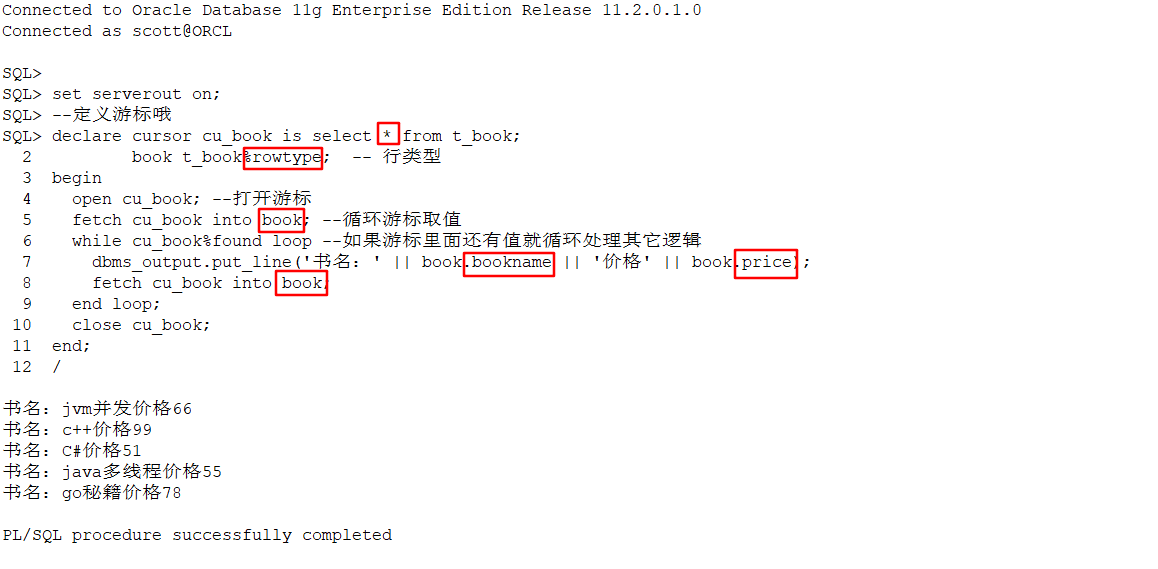
五、隐式游标
不用显示定义游标,但是显示的功能更强大。
1、DML 执行过程中为真,结束后为假
SQL%ISOPEN 布尔型DML 执行过程中为真,结束后为假示例:
begin
if sql%isopen then
dbms_output.put_line('游标打开的');
else
dbms_output.put_line('游标未打开');
end if;
end;输出结果:

2、DML 语句成功执行的数据行数
SQL%ROWCOUNT 整型代表DML 语句成功执行的数据行数示例:
declare b_count number;
begin
select count(*) into b_count from t_book;
dbms_output.put_line('游标捕获行数:'|| sql%rowcount);
end;输出结果:只成功执行了一次DML查询操作。

示例2:
begin
update t_book set bookname='xxxx' where id=11111;
if sql%rowcount=1 then
dbms_output.put_line('执行修改成功');
else
dbms_output.put_line('未执行成功');
end if;
end;输出结果:

未成功,因为没有id=11111的记录。
修改id=1,重新执行;
begin
update t_book set bookname='xxxx' where id=1;
if sql%rowcount=1 then
dbms_output.put_line('执行修改成功');
else
dbms_output.put_line('未执行成功');
end if;
end;
修改成功,因为有id=1的记录,成功执行修改了的。
3、插入、删除、更新或单行查询操作成功
SQL%FOUND 布尔型值为TRUE 代表插入、删除、更新或单行查询操作成功4、与SQL%FOUND 属性返回值相反
SQL%NOTFOUND 布尔型与SQL%FOUND 属性返回值相反六、动态游标
1、定义强类型动态游标
declare type 类名 is ref cursor return 表明%rowtype;2、定义一个动态游标对象
游标对象 类名;示例:查询表中是否有"jvm并发"的书,如果有就输出改记录信息,没有则查询全部记录,并输出。
--定义一个booktype类似一个类
declare type booktype is ref cursor return t_book%rowtype;
--定义一个动态游标对象
cu_book booktype;
--返回行数
b_count number;
--定义一个行类型变量
b_rowdata t_book%rowtype;
begin
select count(*) into b_count from t_book where bookname='jvm并发1';
--如果没有查到JVM并发这本书,就查询全部记录,保存到动态游标中。
if b_count=0 then
open cu_book for select * from t_book; --注意打开游标
else
open cu_book for select * from t_book where bookname='jvm并发';
end if;
--循环游标将每条记录,保存到行变量中。 因为cu_book动态游标里面可能一条数据或全部的记录。
fetch cu_book into b_rowdata;
--判断游标是否还有数据,有就循环输出行变量中字段数据
while cu_book%found
loop
dbms_output.put_line('书名:'||b_rowdata.bookname || '价格:' || b_rowdata.price);
--还有数据就循环将游标数据保存到行变量中
fetch cu_book into b_rowdata;
end loop;
close cu_book;
end;当bookname='jvm并发1'时,不存在该记录,因此查询全部记录信息。
输出结果:
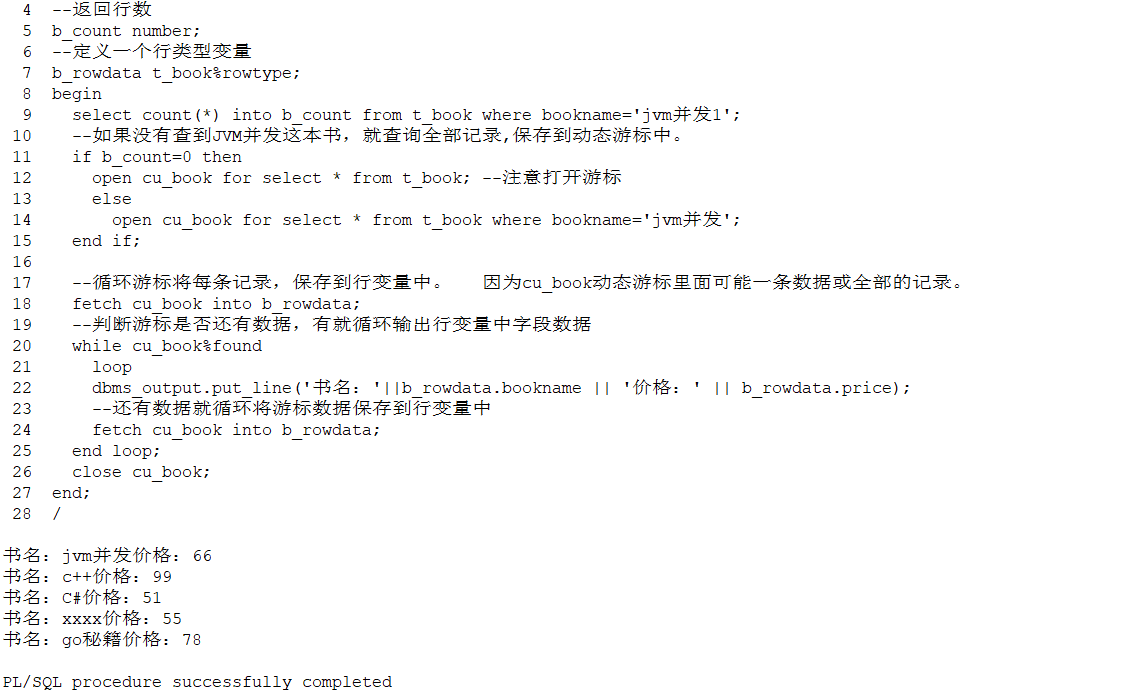
当bookname='jvm并发'时,存在该记录,因此输出记录信息。
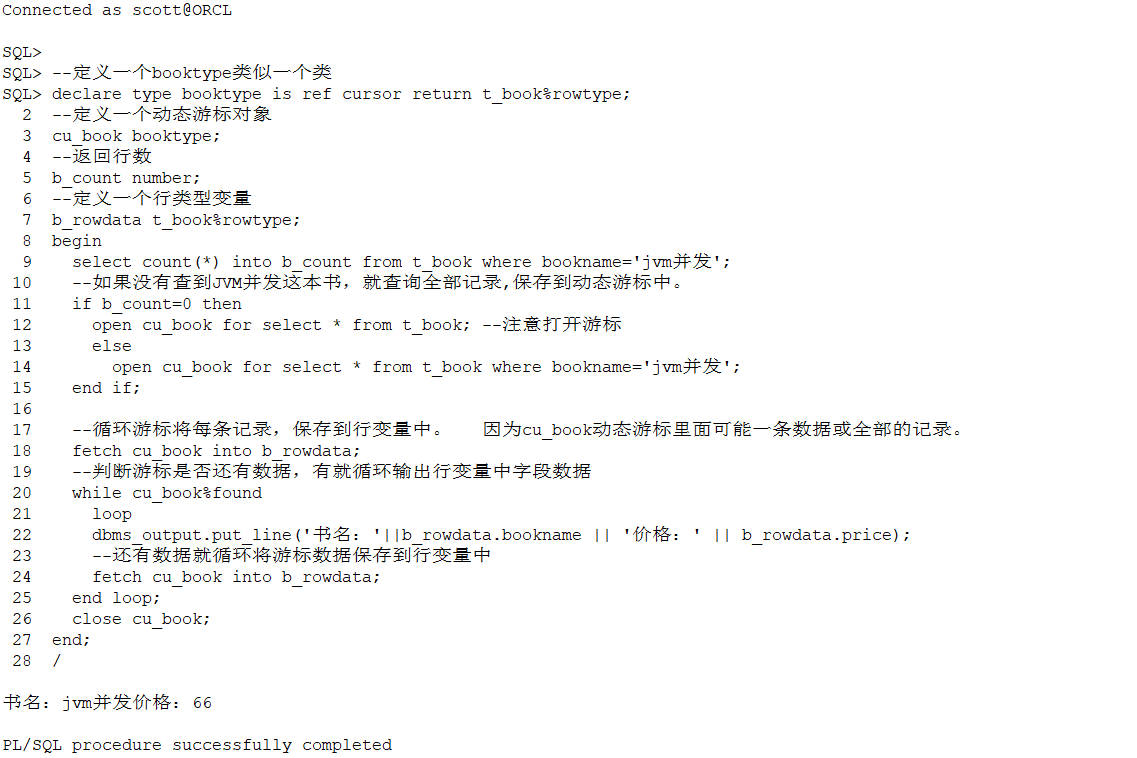
3、定义弱类型动态游标
弱类型比强类型强大。
弱类型动态游标定义,只是少了返回类型的定义,没有了返回值。
declare type 游标类型 is ref cursor;需求:查询t_book中是否有书名为“jvm并发”的记录,有就输出t_book所有记录数据,没有则输出t_booktype表所有记录数据。
原始表数据:


代码:
--定义弱类型动态游标
declare type notknowtype is ref cursor;
--定义一个动态游标对象
notknow notknowtype;
--用于统计是否存在记录
b_count number;
cu_book t_book%rowtype;
cu_booktype t_Booktype%Rowtype;
begin
select count(*) into b_count from t_book where bookname='jvm并发';
if b_count >0 then --不存在
open notknow for select * from t_book; --查询所有t_book数据到游标
--将游标对象循环赋值到t_book行数据中
fetch notknow into cu_book;
while notknow%found --如果游标对象中有数据,则循环输出全部记录信息
loop
dbms_output.put_line('书ID:' || cu_book.id || '书名:' || cu_book.bookname || '价格:' || cu_book.price);
fetch notknow into cu_book;--继续循环一下条数据
end loop;
close notknow;
else
open notknow for select * from t_booktype;
fetch notknow into cu_booktype;
while notknow%found
loop
dbms_output.put_line('t_booktype id:' || cu_booktype.id || 't_booktype name:' || cu_booktype.booktypename);
fetch notknow into cu_booktype;
end loop;
close notknow;
end if;
end;输出结果:
书ID:3书名:jvm并发价格:66
书ID:4书名:c++价格:99
书ID:5书名:C#价格:51
书ID:1书名:xxxx价格:55
书ID:2书名:go秘籍价格:78修改条件中书名为不存在书名,重新执行:
--定义弱类型动态游标
declare type notknowtype is ref cursor;
--定义一个动态游标对象
notknow notknowtype;
--用于统计是否存在记录
b_count number;
cu_book t_book%rowtype;
cu_booktype t_Booktype%Rowtype;
begin
select count(*) into b_count from t_book where bookname='jvm并发111';
if b_count >0 then --不存在
open notknow for select * from t_book; --查询所有t_book数据到游标
--将游标对象循环赋值到t_book行数据中
fetch notknow into cu_book;
while notknow%found --如果游标对象中有数据,则循环输出全部记录信息
loop
dbms_output.put_line('书ID:' || cu_book.id || '书名:' || cu_book.bookname || '价格:' || cu_book.price);
fetch notknow into cu_book;--继续循环一下条数据
end loop;
close notknow;
else
open notknow for select * from t_booktype;
fetch notknow into cu_booktype;
while notknow%found
loop
dbms_output.put_line('t_booktype id:' || cu_booktype.id || 't_booktype name:' || cu_booktype.booktypename);
fetch notknow into cu_booktype;
end loop;
close notknow;
end if;
end;输出结果:
t_booktype id:2t_booktype name:go
t_booktype id:1t_booktype name:java history注意:成对的结束,最后的分号,关闭游标。
七、查看游标
1、查看系统游标数(最大游标数)
select value from v$parameter where name = 'open_cursors';
2、查看当前打开的游标数目
select count(*) from v$open_cursor;
3、查看游标使用情况
select o.sid, osuser, machine,o.sql_id,o.sql_text,o.cursor_type, count(*) num_curs
from v$open_cursor o, v$session s
where user_name = '用户名'
and o.sid = s.sid
group by o.sid, osuser, machine,o.sql_id,o.sql_text,o.cursor_type
order by num_curs desc;
4、修改Oracle最大游标数
alter system set open_cursors=2000 scope=both;5、各用户的打开游标总数
SELECT A.USER_NAME, COUNT(*) FROM V$OPEN_CURSOR A GROUP BY A.USER_NAME;
6、查找数据库各用户各个终端的缓存游标数
SELECT AA.USERNAME, AA.MACHINE, SUM(AA.VALUE)
FROM (
SELECT A.VALUE, S.MACHINE, S.USERNAME
FROM V$SESSTAT A, V$STATNAME B, V$SESSION S
WHERE A.STATISTIC# = B.STATISTIC#
AND S.SID = A.SID
AND B.NAME = 'session cursor cache count'
) AA
GROUP BY AA.USERNAME, AA.MACHINE
ORDER BY AA.USERNAME, AA.MACHINE;
7、查找数据库各用户各个终端的打开游标数
SELECT AA.USERNAME, AA.MACHINE, SUM(AA.VALUE)
FROM (
SELECT A.VALUE, S.MACHINE, S.USERNAME
FROM V$SESSTAT A, V$STATNAME B, V$SESSION S
WHERE A.STATISTIC# = B.STATISTIC#
AND S.SID = A.SID
AND B.NAME = 'opened cursors current'
) AA
GROUP BY AA.USERNAME, AA.MACHINE
ORDER BY AA.USERNAME, AA.MACHINE;


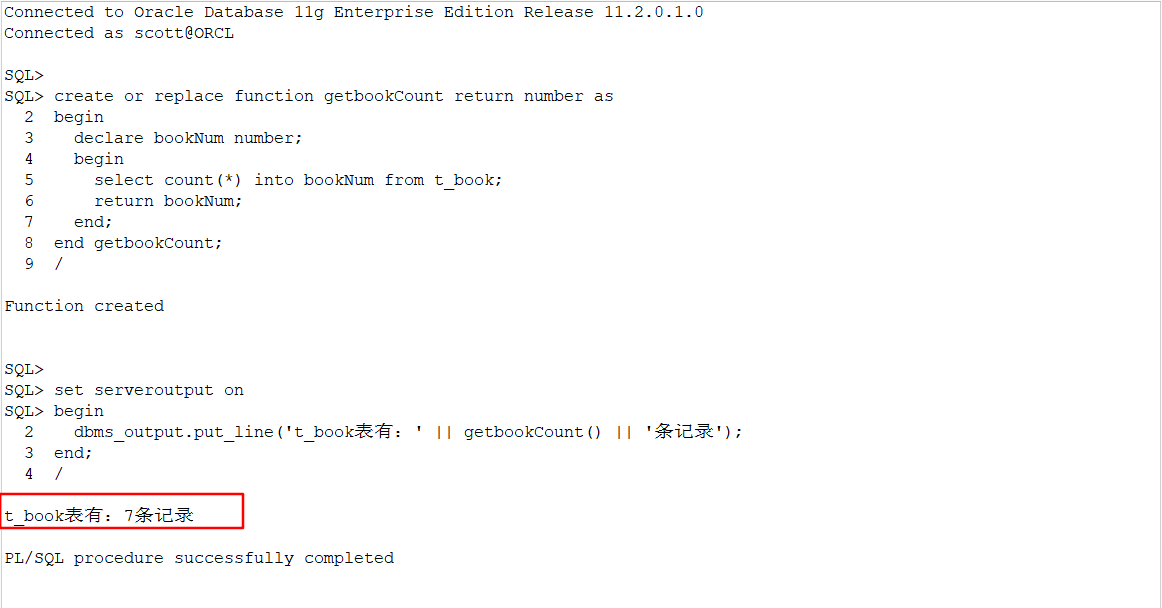



评论 (0)